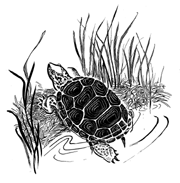Diamondback Terrapins:
A Chesapeake Treasure
By Kathy Reshetiloff
Diamondback terrapins
are turtles that live in marshes and tidal waters along the Atlantic
and Gulf coasts. But it is the northern diamondback terrapin (Malaclemys
terrapin terrapin) that graces the Chesapeake Bay.
 The northern diamondback terrapin is one of the Chesapeake's most
beautiful animals. Because of its elusive behavior, many people
never see this turtle. The diamondback terrapin, however, ranks
right up with the blue crab, oyster, great blue heron or osprey
as a symbol of Chesapeake Bay ecology and history. It's also the
state reptile of Maryland and mascot for the University of Maryland.
The northern diamondback terrapin is one of the Chesapeake's most
beautiful animals. Because of its elusive behavior, many people
never see this turtle. The diamondback terrapin, however, ranks
right up with the blue crab, oyster, great blue heron or osprey
as a symbol of Chesapeake Bay ecology and history. It's also the
state reptile of Maryland and mascot for the University of Maryland.
The top of the turtle is covered with thin, shiny scales called
scutes. This terrapin gets its common name from the concentric
diamond-shaped rings on the scutes of its upper shell. In addition
to this unique pattern, diamondbacks are also very colorful. The
upper shell, known as the carapace, can be gray, black or brown
and the bottom shell, the plastron, is yellow or olive and often
mottled with dark blotches. The skin is pale or white with black
flecks and lines that create a design unique to each individual
terrapin, just like a person's fingerprint.
Males are mature at about 7 years old, weigh about a pound and
are about four inches along the plastron. Mature females are about
12 years old, can weigh up to seven pounds and can reach a length
of nine inches.
Diamondbacks live in brackish and coastal waters and marshes.
Their webbed feet make them agile swimmers and sharp claws help
them move about the marshes. They eat clams, snails, worms, crabs,
insects and fishes. Diamondbacks usually mate in May. Females
can store sperm and produce fertilized eggs up to four years after
mating. Diamondbacks always mate in the water, usually at night.
They lay their pinkish, leathery eggs in June and July in nests
dug out of sandy beaches or marsh edges, above the high-tide line.
On average, a nest will contain about 13 eggs.
Eggs hatch between August and October. With most turtles, temperatures
influence the sex of the hatchlings. Higher temperatures produce
more females while lower temperatures produce more males. It is
believed the same applies to diamondback terrapins. A very late
hatch may cause hatchlings to actually overwinter and hibernate
in the nest and emerge the next year. When they hatch, the turtles
are only about an inch long. Only a small percentage (1-3 percent)
of eggs hatch due to disturbance of the nest or predators. Foxes,
crows and raccoons dig up the nests and eat the eggs and baby
terrapins. Hatchlings are favorite food for herons.
If the hatchlings survive, they will hibernate through the winter.
The first cold temperatures signal terrapins to bury themselves
in mud banks. Body functions slow down so much that the terrapins
do not need to come up to breathe. Hibernation ends in the spring
and mating takes place soon afterwards. Terrapins can live to
be as much as 50 years old.
During colonial times, terrapins were a plentiful source of food,
and terrapin soup soon went from a dish for slaves and servants
to a favorite among all colonists. Demand for terrapins continued
into the late 1800s but supplies continued to decrease. Today,
terrapin season is closed from May 31 through July 31 to allow
for mating and nesting. All harvested terrapins must be at least
six inches long on the plastron.
Besides natural predators, terrapins face other threats. Habitat
loss is a big factor. Terrapins appear to stay close to beaches
and waterways where they hatched. If traditional nesting areas
are altered by waterfront development, it is not likely that the
terrapins will nest elsewhere. Bulkheads, stone revetments and
even shoreline grass plantings can ruin nesting habitat. Increased
motor boat traffic increases the likelihood that terrapins will
be hit by propellers. Crab pots in shallow water areas, like off
of docks, also pose a problem. Terrapins go after the crab bait,
get stuck in the pots and drown. Today, catch reduction devices
are required in all non-commercial crab pots. The wire device
lets crabs in but keeps terrapins out.
In order to protect and conserve this wonderful creature, we must
continue to learn more about its habits and habitat. The Terrapin
Research Consortium is a research advisory group independent of
political, academic and government organizations. Its goal is
to develop sound research and management of diamondback terrapins
throughout their range. For more information about this group,
visit their website at www.terrapininstitute.org/consortium.htm.
For more information about diamondbacks or to get involved in
terrapin conservation, visit the Maryland Department of Natural
Resources "Terrapin Station" www.dnr.state.md.us/fisheries/recreational/terpstation.htm.
Kathryn Reshetiloff is employed by the Fish and Wildlife Service, U.S. Department of the Interior. Illustration by Laurie Hewitt, U.S. Fish and Wildlife Service.
|
Back
|

